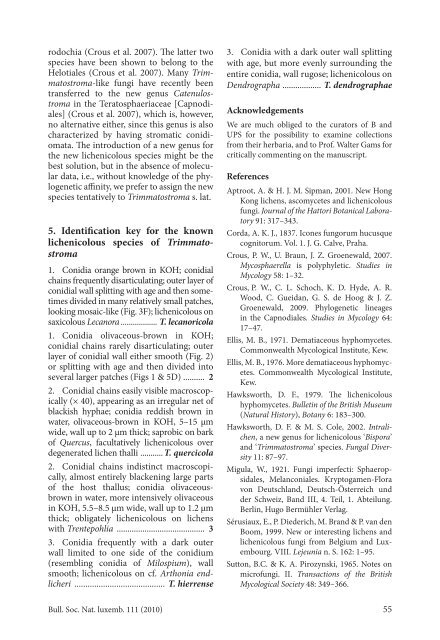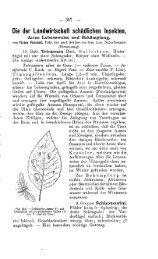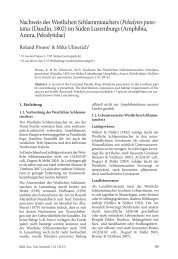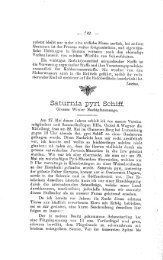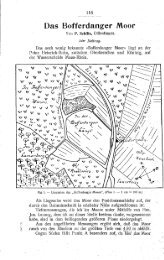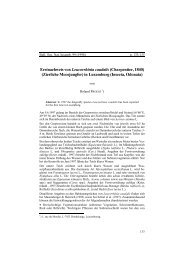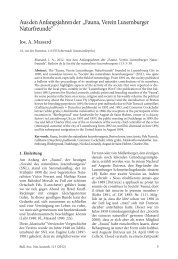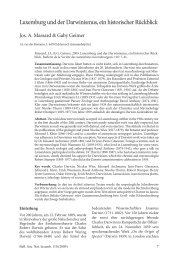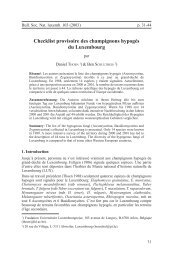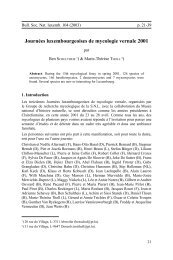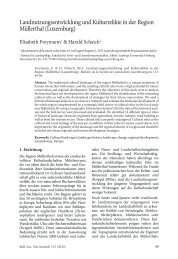Four new lichen-associated Trimmatostromaspecies ... - SNL
Four new lichen-associated Trimmatostromaspecies ... - SNL
Four new lichen-associated Trimmatostromaspecies ... - SNL
You also want an ePaper? Increase the reach of your titles
YUMPU automatically turns print PDFs into web optimized ePapers that Google loves.
odochia (Crous et al. 2007). The latter two<br />
species have been shown to belong to the<br />
Helotiales (Crous et al. 2007). Many Trimmatostroma-like<br />
fungi have recently been<br />
transferred to the <strong>new</strong> genus Catenulostroma<br />
in the Teratosphaeriaceae [Capnodiales]<br />
(Crous et al. 2007), which is, however,<br />
no alternative either, since this genus is also<br />
characterized by having stromatic conidiomata.<br />
The introduction of a <strong>new</strong> genus for<br />
the <strong>new</strong> <strong>lichen</strong>icolous species might be the<br />
best solution, but in the absence of molecular<br />
data, i.e., without knowledge of the phylogenetic<br />
affinity, we prefer to assign the <strong>new</strong><br />
species tentatively to Trimmatostroma s. lat.<br />
5. Identification key for the known<br />
<strong>lichen</strong>icolous species of Trimmatostroma<br />
1. Conidia orange brown in KOH; conidial<br />
chains frequently disarticulating; outer layer of<br />
conidial wall splitting with age and then sometimes<br />
divided in many relatively small patches,<br />
looking mosaic-like (Fig. 3F); <strong>lichen</strong>icolous on<br />
saxicolous Lecanora................... T. lecanoricola<br />
1. Conidia olivaceous-brown in KOH;<br />
conidial chains rarely disarticulating; outer<br />
layer of conidial wall either smooth (Fig. 2)<br />
or splitting with age and then divided into<br />
several larger patches (Figs 1 & 5D) .......... 2<br />
2. Conidial chains easily visible macroscopically<br />
(× 40), appearing as an irregular net of<br />
blackish hyphae; conidia reddish brown in<br />
water, olivaceous-brown in KOH, 5–15 µm<br />
wide, wall up to 2 μm thick; saprobic on bark<br />
of Quercus, facultatively <strong>lichen</strong>icolous over<br />
degenerated <strong>lichen</strong> thalli ........... T. quercicola<br />
2. Conidial chains indistinct macroscopically,<br />
almost entirely blackening large parts<br />
of the host thallus; conidia olivaceousbrown<br />
in water, more intensively olivaceous<br />
in KOH, 5.5–8.5 µm wide, wall up to 1.2 μm<br />
thick; obligately <strong>lichen</strong>icolous on <strong>lichen</strong>s<br />
with Trentepohlia .......................................... 3<br />
3. Conidia frequently with a dark outer<br />
wall limited to one side of the conidium<br />
(resembling conidia of Milospium), wall<br />
smooth; <strong>lichen</strong>icolous on cf. Arthonia endlicheri<br />
.......................................... T. hierrense<br />
3. Conidia with a dark outer wall splitting<br />
with age, but more evenly surrounding the<br />
entire conidia, wall rugose; <strong>lichen</strong>icolous on<br />
Dendrographa .................. T. dendrographae<br />
Acknowledgements<br />
We are much obliged to the curators of B and<br />
UPS for the possibility to examine collections<br />
from their herbaria, and to Prof. Walter Gams for<br />
critically commenting on the manuscript.<br />
References<br />
Aptroot, A. & H. J. M. Sipman, 2001. New Hong<br />
Kong <strong>lichen</strong>s, ascomycetes and <strong>lichen</strong>icolous<br />
fungi. Journal of the Hattori Botanical Laboratory<br />
91: 317–343.<br />
Corda, A. K. J., 1837. Icones fungorum hucusque<br />
cognitorum. Vol. 1. J. G. Calve, Praha.<br />
Crous, P. W., U. Braun, J. Z. Groe<strong>new</strong>ald, 2007.<br />
Mycosphaerella is polyphyletic. Studies in<br />
Mycology 58: 1–32.<br />
Crous, P. W., C. L. Schoch, K. D. Hyde, A. R.<br />
Wood, C. Gueidan, G. S. de Hoog & J. Z.<br />
Groe<strong>new</strong>ald, 2009. Phylogenetic lineages<br />
in the Capnodiales. Studies in Mycology 64:<br />
17–47.<br />
Ellis, M. B., 1971. Dematiaceous hyphomycetes.<br />
Commonwealth Mycological Institute, Kew.<br />
Ellis, M. B., 1976. More dematiaceous hyphomycetes.<br />
Commonwealth Mycological Institute,<br />
Kew.<br />
Hawksworth, D. F., 1979. The <strong>lichen</strong>icolous<br />
hyphomycetes. Bulletin of the British Museum<br />
(Natural History), Botany 6: 183–300.<br />
Hawksworth, D. F. & M. S. Cole, 2002. Intra<strong>lichen</strong>,<br />
a <strong>new</strong> genus for <strong>lichen</strong>icolous ‘Bispora’<br />
and ‘Trimmatostroma’ species. Fungal Diversity<br />
11: 87–97.<br />
Migula, W., 1921. Fungi imperfecti: Sphaeropsidales,<br />
Melanconiales. Kryptogamen-Flora<br />
von Deutschland, Deutsch-Österreich und<br />
der Schweiz, Band III, 4. Teil, 1. Abteilung.<br />
Berlin, Hugo Bermühler Verlag.<br />
Sérusiaux, E., P. Diederich, M. Brand & P. van den<br />
Boom, 1999. New or interesting <strong>lichen</strong>s and<br />
<strong>lichen</strong>icolous fungi from Belgium and Luxembourg.<br />
VIII. Lejeunia n. S. 162: 1–95.<br />
Sutton, B.C. & K. A. Pirozynski, 1965. Notes on<br />
microfungi. II. Transactions of the British<br />
Mycological Society 48: 349–366.<br />
Bull. Soc. Nat. luxemb. 111 (2010) 55


